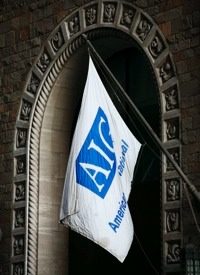
A year after the onset of the greatest financial crisis since the Great Depression, details continue to emerge of the sordid secret deals cut by the Federal Reserve in bailing out certain financial giants. The very latest, courtesy of Bloomberg News, alleges that the Federal Reserve Bank of New York, under the leadership of Timothy Geithner (now U.S. Treasury Secretary), engineered a sweetheart deal to pay off holders of AIG debt at par, rather than the 40 cents on the dollar that AIG negotiators had been pushing for.
While the full story of the secretive backroom deals cut by the New York Fed with the likes of Goldman-Sachs, France’s Société Générale, and Germany’s Deutsche Bank have yet to be fleshed out, it appears clear that the entire affair, which wound up costing U.S. taxpayers around $13 billion, was engineered to benefit a small cadre of financial insiders at the expense of everybody else.
Case in point: Stephen Friedman, who at the time was Chairman of the New York Fed’s Board of Directors and also sat on the board of Goldman-Sachs, was chief negotiator on the Fed team that finally hammered out the deal with AIG’s creditors. Weeks after the payments to Goldman-Sachs and the other banks had been authorized — but long before the identities of AIG’s counterparties were made public in the spring by an outraged Senator Christopher Dodd — Friedman quietly purchased 56,600 shares of Goldman-Sachs. As of October 26, 2009, shares of Goldman-Sachs closed at almost $180.00, more than twice what Friedman paid for them last December, giving this particular financial insider a cool $5.4 million profit. According to Jerry Jordan, former president of the Federal Reserve Bank of Cleveland, “it’s an outrage. He needed to either resign from the Fed board or from Goldman and proceed to sell his stock.”
Ah, but what’s the fun in bailing out your friends if messy moralizing gets in the way? The usual outcome in resolving obligations gone sour is far less than 100 cents on the dollar. “In cases like this, the outcome is always along the lines of 50, 60 or 70 cents on the dollar,” Donn Vickrey, a financial analyst from Gradient Analytics, Inc., told Bloomberg. But once the Federal Reserve interjected itself – and the unlimited backing of U.S. taxpayer dollars — into the AIG negotiations, creditors began driving a much harder bargain, insisting on being paid in full or risk failure themselves. Moreover, according to Bloomberg, the Fed did not want to bother cutting separate deals with the various counterparties.
As of this writing, Bloomberg News “has filed a Freedom of Information Act request seeking copies of the term sheets related to AIG’s counterparty payments, along with e-mails and the logs of phone calls and meetings among Geithner, Friedman and other New York Fed and AIG officials,” according to Bloomberg’s own report. A previous FOI request for information on secret Fed dealmaking, filed last November by Bloomberg LP, Bloomberg News’ parent company, was approved in August by a Manhattan Chief U.S. District Judge, but is still tied up in the courts after the Fed, determined to keep its secrets, appealed to the Second Circuit Court of Appeals.
That the Federal Reserve should act so secretly and brazenly in defense of Wall Street financial interests should come as a surprise to no one acquainted with its history. The central bank was planned and set up by Wall Street bankers and financiers and their congressional toadies, and was designed to guarantee the unassailability of the New York-centered financial system (the financial wing of the so-called “Eastern Establishment”).
Other regional branches of the Fed were set up around the country to create the illusion of a disinterested central bank operating without regional partiality. But from the outset, the New York Fed has controlled the workings of the entire system, because it is the New York Fed that oversees the Fed’s “open market operations,” whereby the Fed buys and sells securities from certain privileged brokerages.
The first head of the New York Federal Reserve Bank, Benjamin Strong, ruled the entire system with an iron hand until his death in 1928. It was Strong who had a close friendship with Bank of England Governor Montagu Norman, a relationship that allowed the two men to effectively control the world’s finances during the 1920s — and whose policies created the financial bubble that burst in October 1929 with calamitous consequences. During Strong’s tenure, the actual chairman of the Federal Reserve and the Board of Directors in Washington had virtually no say in the Fed’s policymaking. Fed Chairman Marriner Eccles, a Utahn who disapproved of the Fed’s New York power center, engineered in the 1930s reforms that gave Fed officials in Washington more control over the organization, but the pivotal role of the New York Fed in the entire system remains unchanged.
While we wish Bloomberg success in its work to bring to light the full story of last fall’s skullduggery at the New York Fed, the nature of the system itself will not change. The Fed will continue to prop up the Wall Street financial interests crucial to its own survival, and the taxpayer will always be obliged to foot the bill. Only by abolishing the entire corrupt Federal Reserve system will American taxpayers be freed from the burden of periodically bailing out Wall Street elites.
Photo: AP Images



